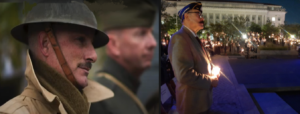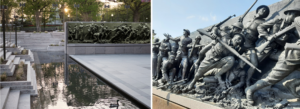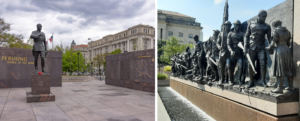Washington DC’s Heroic New WWI Memorial, ‘A Soldier’s Journey’
September 16, 2024 / Helen Kachur

A dramatic high relief bronze monument titled, A Soldier’s Journey, by sculptor Sabin Howard commemorates the first World War One monument in Washington DC.
Last Friday night as evening fell on the busy streets of Washington DC, The WWI Centennial Commission and Doughboy Foundation unveiled a new 58-foot long bronze WWI memorial of thirty-eight individually carved figures. The featured centerpiece of a newly renovated John Pershing Plaza, was designed by sculptor Sabin Howard who aptly titled his work, A Soldier’s Journey.
In an illumination ceremony of military fanfare and ballads played by the US Army Band, visiting dignitaries gathered around the memorial to share in heartfelt speeches of remembrance, as the city’s first WWI monument was officially turned over to Washington DC’s Department of Parks. The huge memorial captivated guests with a visual presentation of opposites; contrasting a young girl to men physically engaged in war, and the customary stillness of a reflecting pool to the sculptured turbulence of battle charging infantry.

A Young Architect’s Park Design
In the year 2015, the WWI Continental Commission award for a John Pershing Park renovation was notable by the selection of Joseph Weishaar. Joseph was a Chicago intern – not yet licensed architect, who at the age of twenty-five had little work experience. In support of his new design build, the architectural firm GWWO out of Baltimore was hired to oversee construction and land development. The WWI Commission committee members took special interest in Weishaar’s design specification, that stipulated a traditional ‘figurative monument’ in lieu of modern conceptual art. With all parties in agreement to the site development, a collaborative of architects, artist and land developer worked towards a new balanced park restoration of open court areas, fountain and statue centerpiece.
The design team’s site plan introduced new structural elements of two ten-foot engraved granite information walls and a belvedere to quickly read over lower-level court walkways, stepped seating, sculpture and reflecting pools. Bermed earth with plantings, now surround the court perimeter and act as effective sound barriers to busy pedestrian streets. Near the berm, but secluded to the back of the long bronze sculpture, stands the granite Peace Fountain. Its wall of gently falling water passes behind raised text excerpts of Archibald MacLeish’s poem, “The Young Dead Soldiers Do Not Speak,” which begins;
-
-
- “…They say, We were young. We have died. Remember us.
They say, We have done what we could but until it is finished it is not done…
They say, We have given our lives but until it is finished no one can know what our lives gave.
They say, Our deaths are not ours: they are yours: they will mean what you make them.”
- “…They say, We were young. We have died. Remember us.
-

Follow the Enlisted Guy
Sabin Howard described his WWI monument, A Soldier’s Journey, as a personal service dedicated to the military, but for the public. His initial project criterion, as defined by the WWI Commission prospectus, was a sobering task, ” … to design a memorial in tribute and honor of 4.7 million WWI service members, and over 116,000 who gave their lives” Howard chose a concept to represent the whole, by distilling his design into just one man’s war experience. Displayed across a colossal 58-foot length bronze work he created 38 life-size figures, grouped into five unique panels of sequenced events.
Howard’s war memorial has since been met with much approval. It now stands through the day in elegant sculpted high-relief of figures that become animated by direct sunlight that cast shadows and movement across its long surface. His first panel features a civilian’s recruitment and swift departure to awaiting fellow infantry in the midst of battle. Following through the scenes, physical gestures and weary faces are filled with raw emotion, absent of heroic symbolism or embellishment. Howard’s narrative comes to an end in silent victory, as marked by a young girl who receives her father’s army combat helmet as a sign of formal discharge.
Through dramatic gestures and the facial expressions of his bronze figures’, Sabin Howard’s memorial fully acknowledges the severity of war, offering no resolution yet maintains some small ownership to the past. Each grouping of his carefully arranged figures, clearly define the emotional and physical toll of conflict; where lives were disrupted, men were lost, and many left homes without assurance or plan for safety.

“Freedom is never more than one generation away from extinction.” – President Ronald Reagan


